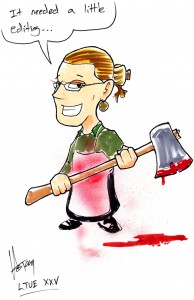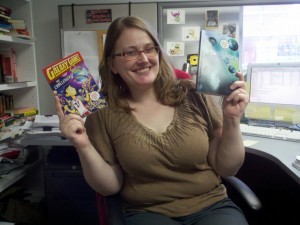I’ll be in Utah this February again this year for the excellent science fiction/fantasy convention Life, the Universe, and Everything. It’s the convention’s 30th anniversary this year. Normally it’s hosted at Brigham Young University, but due to scheduling difficulties it’ll be held this year at neighboring Utah Valley University only a few miles away—and a few miles closer to my greatest restaurant love, a restaurant I have yet to find matched in New York City (seriously), Sakura. Seriously, best deep-fried sushi (sometimes called tempura—not just for shrimp!) that I’ve found anywhere. Particularly the Geisha, Spider, Firecracker, Ninja, and Hawaiian rolls. If you’re in Utah and you haven’t discovered this place yet (and you’re not Jessica Day George) GO. It’s SO GOOD.
But I digress. (Good sushi can do that to me.)
Anyway, my point is that you need to attend LTUE, especially if you live in the Intermountain West. Sure, they’ve started charging a nominal fee (it used to be free), but that fee makes sure this great convention can continue to happen every year, giving them a modest budget for facilities, guests of honor, and so forth. The committee that runs the con are all volunteers.
Speaking of guests of honor, I’m looking forward to meeting a longtime internet but not (yet) real-life friend, James A. Owen. He’ll be talking about both writing and illustration, including a whole seminar on how to draw dragons, so if you’re an illustrator, you want to come to this LTUE.
Also attending will be the Writing Excuses team—not just locals Brandon Sanderson, Dan Wells, and Howard Tayler, but also SFWA vice president, puppeteer, and author Mary Robinette Kowal, not to mention a number of locally-based pros, writers and editors like Mette Ivie Harrison, Larry Correia, James Dashner, Bree Despain, J. Scott Savage, Tyler Whitesides, Chris Schoebinger, Robert J. Defendi, Lisa Mangum, and many more.
Check out the full schedule here (where there may be some tweaks to the schedule, so you might want to check back before the con), but here’s my schedule:
Thursday, February 8, 2012
10:00 AM—What Exactly Does an Editor Do, Anyway? (Rick Walton (M), Stacy Whitman, Suzanne Vincent, Lisa Mangum, Kirk Shaw)
11:00 AM—Middle-grade books for boys (Tyler Whitesides, E. J. Patten, Michael Young, Stacy Whitman(M))
2:00 PM—Feeling Fake: What to do about that pervasive feeling that everyone belongs in the publishing world except you. (Sandra Tayler, Jason Alexander, Ami Chopine (M), Stacy Whitman)
7:00 PM—A Vampire is NOT your Boyfriend!: Real Vampires (Mette Ivie Harrison, Michael R. Collings, Dan Lind, Stacy Whitman(M))
Friday, Febrary 10, 2011
No panels for me, though I will be around the convention, so I’m open to individual meet-ups for lunch (particularly at Sakura…). I’m also looking forward to James Owen’s main address this day, and the Writing Excuses live podcast. .
EDIT: I have been added to the below panel to give the editorial side:
6:00 PM—Book Bombs: How to make an Amazon.com bestseller (Randy Tayler (M), Robison Wells, Larry Correia, Stacy L. Whitman, Michaelbrent Collings)
Saturday, February 11, 2012
1:00 PM—Writing Cross-Culturally: Mistakes to Avoid, or, How to Avoid Cultural Misappropriation (Stacy Whitman)
This will be a workshop in which we talk about all the mistakes that even well-meaning authors can make in diversifying our writing, and how to use strong worldbuilding and characterization to prevent that. Also: how making mistakes doesn’t mean we’re racist—it just means we’re willing to learn.
2:00 PM—Plots, Subplots, and Foreshadowing (Bree Despain (M), J. Scott Savage, Brandon Sanderson, James A. Owen, Stacy Whitman)
I’m not on the following workshop, but want to highlight it because both Sandra and Mary are people to learn from, and given that the workshop will be two hours long, you’ll get an opportunity to really go in depth.
3:00-5:00 PM
– The Published (and aspiring) Author’s Toolbox: Learning skills for networking, blogging, social media, and self-promotion. This workshop will teach principles and give you a chance to practice skills to integrate networking, blogging, social media, and self-promotion into your professional life without being the person who annoys and without pulling you out of balance with yourself.
(Sandra Tayler, Mary Robinette Kowal)


 One thing we talked about is how the industry itself is working on awareness and furthering diversity among the books themselves and future publishing personnel. Last night, we launched the
One thing we talked about is how the industry itself is working on awareness and furthering diversity among the books themselves and future publishing personnel. Last night, we launched the  These questions are from chapter 9 of the excellent book
These questions are from chapter 9 of the excellent book  Also: I loved that there were several Koreans in my seminar over the course of the day, two in one session alone! After that session, we got to talking about why and how I’m learning Korean, so I wanted to give a shout-out to the excellent
Also: I loved that there were several Koreans in my seminar over the course of the day, two in one session alone! After that session, we got to talking about why and how I’m learning Korean, so I wanted to give a shout-out to the excellent